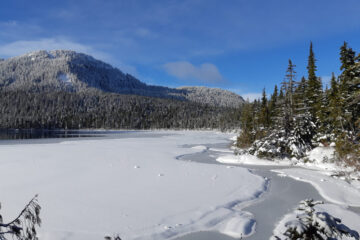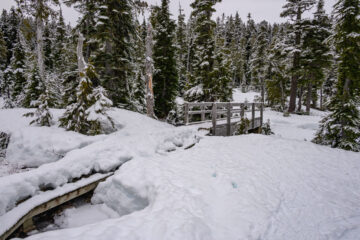A Brief E-Newsletter for Mid August.
 Mt Drabble Tarn, July 20th, 2022
Mt Drabble Tarn, July 20th, 2022
GENERAL NEWS
The weather finally changed in a radical way during the 3rd week of July. On the 18th there was still snow on the top of Mt Elma, and patches on the trails on the Plateau level above Lake Helen Mackenzie towards Circlet. By the 22nd all that had changed. Mt Elma was all but clear of snow, and the muddy trails on the plateau were finally drying out.

SWI successfully hosted a small, no frills gathering of Botany BC on the 22nd and 23rd of July. Participants in any of the various outings below 1100m on the Plateau could find a broad array of subalpine plants that had recently come into bloom for example at Divers Lake, or McKenzie Meadows, but the higher elevation areas selected for our visitors, such as the summit ridge of Mt Elma (photo above), still lacked plants in bloom. On the other hand mosses and lichens, as well as slime molds were still enjoying the high humidity, unusual for late July (for photos of slime molds see next section below). 
Each day after the outings there were presentations in the Ruth Masters Nature Hall. SWI Director and biologist, Dr. Loys Maingon in “Understanding the SWI Project and the Embarrassment of Species” spoke on the successes of the SWI iNaturalist Project, one that has no funding other than the CSJ salaries for our summer students. Dr Randal Mindell, a former SWI Director and Bryophyte specialist in “A Deep History of Bryophytes in the Pacific Northwest”.spoke on the wealth of fossilized mosses that have been discovered locally in the Tsolum River.

The SWI Summer Programme of Interpretive Walks and Hikes is now well underway, capably coordinated by one of our CSJ students, Mateo, who also led one of our recent hikes around the Battleship-Helen MacKenzie loop, as well as accompanying the guided walks around the paradise Meadows loops.

Two other CSJ students, Jack and Steven, have been busy out in the trails documenting flora and fauna for our global inventory. Because of the deeper, late melting snowpack in the Alpine, most of the terrain covered this year has been at lower elevations in the Buttle area ( such as Wolf River, Price Creek, Isardi Creek and most recently the Bedwell Trail, following the Bedwell River out to the western borders of the Park.

Amongst other interesting contributions to the growing inventory of species in the Park, is the addition of 5 populations of the red-listed Old Growth Specklebelly lichen to the one already documented in the Wolf River area.
Below is an example of this lichen from beside the Arnica LakeTrail, taken on the recent scheduled hike in the Buttle area.
More news of the additions to the SWI DATA COLLECTION PROJECT (https://www.inaturalist.org/
NATURE NOTES
Early in July as the snow receded from the subalpine “spring” fungi were appearing in profusion, benefitting from the extra moisture after last summer’s drought. We are looking forward to an abundance of fungi in September for our annual Mycology Workshop ( which has already reached its maximum number of participants.) 2 “spring” fungi below :
 .Caloscypha fulgens = spring orange-peel fungus
.Caloscypha fulgens = spring orange-peel fungus
 Gyromitra californica
Gyromitra californica
Also abundant as the snows receded have been slime moulds and like organisms (Protozoans) which feed on the microorganisms that live in any type of dead plant material. Like fungi they aid in the decomposition of dead vegetation and so they are usually found on the forest floor, commonly on fallen logs or dead stumps. Some of these do have common names, many do not (so apologies to those not into taxonomic nomenclature.). Most of these will now have vanished as the moisture in the atmosphere vanishes.


Probably best known are the Wolf’s Milk (Lycogala epidendrum) which is often pink, but sometimes orange or gray and the dubiously named Dog Vomit or Troll’s Puke (Fuligo septica) which is usually a brilliant yellow when fresh.

Below are some other examples:

Ceratiomyxa fruticulosa or Honeycomb coral
 . Lindbladia tubulina
. Lindbladia tubulina


Stemonitis flavogenita ( on a fir twig)
Prevalent too, with the extra moisture, are the mosquitoes and biting flies, which though not popular with hikers, do provide necessary food for birds, so there are lots of Nighthawks around the Meadows – mostly visible high above the trees but we were fortunate to come across this young nighthawk on the ridge south of Croteau Lake vociferously demanding food from a parent .

Chordeiles minor – Common Nighthawk
Also good insect predators are the many species of dragonflies. The golden coloured example below from the meadow area at Arnica Lake may be a species of Leucorrhinia or Whiteface.

UPCOMING EVENTS
- TrailRider Day #2. August 20th 10:00 am onwards – Paradise Meadows

- Guided Walks in Paradise Meadows
August 21st 9.30-noon :Trees in Subalpine Environment. Forester and naturalist Fred Newhouse will identify the species of fir, pine and cedar commonly found in the subalpine and show how they adapt to their environment.
August 27th 9:30 -noon “Liking the Lichens”. Retired forester and lichen expert Margaret Symon will identify the variety of lichen species found in the subalpine pointing out the roles they play in their ecosystems.
- Longer hikes up on the Plateau
August 28th 8.30 am. Cruikshank Canyon Lookout. Avid hiker and runner, Leslie Dargie will lead this strenuous day hike (21k round trip) to the Cruikshank Canyon Lookout, featuring a spectacular view of the canyon and mountains beyond, as well as several subalpine lakes along the way. Pack a lunch and plenty of water.
September 3rd 8: 30 am. Mariwood Lake. Avid Hiker and CDMC Vice President Janet Beggs will lead a moderate day hike (7-8hrs, 19-20km round trip) to scenic Mariwood Lake (located south of Kwai Lake). Pack a lunch and plenty of water.
- *FILM SHOW*
August 26th “The Zone” – Tidemark Theatre,
Campbell River
from 5:00 pm on, with book signing at 6:00 pm and film screening at 6:30 pm
The film, whose title is derived from Rob Wood’s latest book: The Zone: Rediscovering Our Natural Self, follows Rob’s ascent of Mt Van der Est against the odds as he faces the challenges of living with Parkinson’s disease. Rob’s life was always one full of action — as a mountaineer and environmental activist, and homesteader off the grid on Maurelle Island. As an instructor in the Outdoors Programme at Strathcona Park Lodge he naturally became one of the founding members of the Friends of Strathcona Park in their protest again mining in the Park at the end of the 1980s. He subsequently became a founding director of Strathcona Wilderness Institute as an educational extension of FOSP and provided the architectural design for our Centre at Paradise Meadows.


